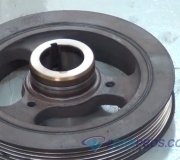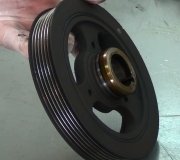"Harmonic balancer" and "vibration damper" are the same thing. Based on weight, weight distribution, size, and all kinds of other variables, every crankshaft has a tendency to vibrate and bend in the middle at a certain rpm. The vibration damper is of the correct mass to dampen those vibrations. A harmonic occurs at two, three, four, times that rpm. Those vibrations become accentuated at higher speeds and would be more noticeable, so that is where most effort is put into counteracting them. The manufacturer may call it a harmonic balancer.
The majority of harmonic balancers have a center hub and a separate outer ring that has a lot of mass. The two parts are glued together with a type of rubber that allows the ring to move just a little. Some of them have grooves in the outer ring to form the drive pulley for a ribbed serpentine belt. Some have that pulley bolted to the hub instead. Those are made from stamped steel.
Two types of vibrations need to be stopped. The easiest to understand is torsional vibration. Each time a piston gets pushed down on a power stroke, it pushes on its crankshaft "journal". That is on the end of what is, in effect, a lever that is part of the crankshaft. The goal is to cause the crankshaft to rotate. Meanwhile, that rotating crankshaft has other journals that are pushing pistons up on their energy-robbing compression and exhaust strokes. Those forces make the crankshaft want to twist the other way. You can easily feel the roughness of the power pulses on an idling four-cylinder engine, or better yet, a single-cylinder utility engine. Six-cylinder and V-8 engines have more power pulses in the same amount of time, so they feel smoother, but those twisting forces are still there. There are more of those twisting pulses, but they are less easy to feel.
The second type of vibration comes from the crankshaft wanting to bend down in the middle from the force of a piston in the center of the engine, and bend up on the ends of the crankshaft. Visualize it like the two parenthesis keys on your keyboard. The tops and bottoms of those symbols are the ends of the crankshaft. That is longitudinal vibration, and is typically very weak and impossible to notice. Where it is most commonly seen is in racing engines. Some older GM V-8 engines will actually crack the crankshaft into three pieces if they are run at very high rpm with the wrong vibration damper. The tiny amount of flexing has a big impact at 7,000 - 8,000 rpm. When this damage occurs, you can grab the damper and move it up and down and flop it around.
Some crankshafts have a characteristic vibration felt at a specific engine speed that is much more noticeable when there is no load on it, as when holding the engine at a high speed while in neutral. Those have two different vibrations, and there may be a speed at which both occur at the same time. You can see that by watching the ripples in water in a cup on the dashboard. If it's real bad, a can of soda can walk across the dashboard! Running at high speed with no load is not a normal condition, so the manufacturer will not waste resources trying to eliminate those vibrations. They are concerned with what you could feel under normal driving situations, or those that could cause a catastrophic failure.
The same vibrations are seen at the rear of the crankshaft. The mass of the flywheel and/or torque converter are needed to do the damping there. On some designs, counterweights need to be added to the vibration damper and the flywheel or torque converter. For those at the rear, they will have an offset attaching bolt hole so the parts can only be oriented one way. That insures those added weights will always be in the proper relationship to where they are needed by the crankshaft. You will have a very noticeable and miserable vibration that defies diagnosis if the wrong part is used
Wednesday, March 1st, 2017 AT 4:02 PM





